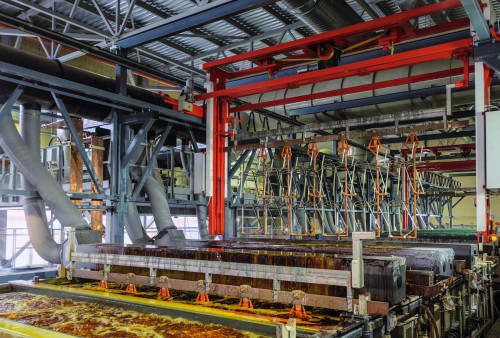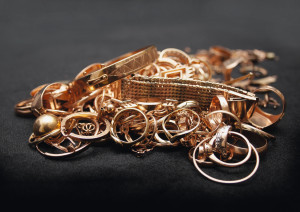The new training year has begun. For some trainees it is the first year, for others the last. Everyday working life in surface technology can be very different, as there is hardly a more varied profession. As an apprentice, you wonder what the future might look like. We received an article about this from Lara Fuchs, who gives us a little insight into her working world.
A year ago, I passed my exam to become a surface coater. Since then, I've been working in the hand electroplating department at my training company. Here we mainly, but not exclusively, electroplate small parts. In addition to gold and silver, we also nickel-plate, copper-plate, chrome-plate, tin-plate, anodize aluminium and electropolish stainless steel. There is no lack of variety in sight.
 Detail of an electroplating line. Production process of galvanic copper plating, nickel plating and chrome plating of steel products
Detail of an electroplating line. Production process of galvanic copper plating, nickel plating and chrome plating of steel products
My working day starts at 7 o'clock. Thanks to timers, all the heaters and filter pumps are already running. I already prepared some of the goods yesterday. I immediately hang the first racks with oily steel parts that are to be copper-plated and nickel-plated in the appropriate boil-off degreaser.
 Old gold that may one day be part of a gold anode. Connectors are gold-plated in Lara Fuchs' hand electroplating shop. (Photo: stock.adobe.com/Cloudy Design)
Old gold that may one day be part of a gold anode. Connectors are gold-plated in Lara Fuchs' hand electroplating shop. (Photo: stock.adobe.com/Cloudy Design)
The air is very pleasant and the extraction systems work well. I'm pleased about that because we had problems with this last month. I walk through the manual electroplating shop, checking the condition of the pumps, valves and tanks. I turn on the sinks and fill up some of the baths with water, the evaporation losses of which are noticeable from the falling water level.
As soon as I've finished the tour, the steel parts are transferred from the degreasing to the pickling bath and the next racks to the boiling degreasing bath. This continues until the cyanide copper bath is full and the first parts can be copper-plated. This is followed by a short meeting.
Hand electroplating is not only used for production, but also for initial sampling
We have several large systems. Hand electroplating is not only used for production, but also for initial sampling. Together with the people responsible for the barrel plant, the production manager and the technical management, we discuss the process for new sample parts. These are turned brass parts that have to be nickel-plated and tin-plated. First we discuss whether I should electroplate them in a small drum or in a vibrator (vibrating plate). It quickly becomes clear that the drum is a better simulation of later mass production. It is agreed that the technical management will define a workflow with all the parameters and hand it over to me soon.
In the meantime, I am back in my department preparing copper parts for silver plating. In addition, small plug contacts are to be gold-plated, which I have long since sent for pre-treatment in the vibrator.
As a rule, the processes are clearly defined and it's up to me to decide which orders are to be plated and when.
In the meantime, the technical management has arrived with the parts for tinning. I have to check the specifications for initial samples, which I do immediately. I couldn't find any errors in either the process or the calculations, which is why I put the brass parts in a small drum and send them to pre-treatment. After numerous production steps and beautifully coated parts, it's time for lunch.
The break in the manual electroplating shop lasts an hour. If possible, I try to have parts that need a thick coating in the bath during this time. Today I succeeded in copper plating and tinning, but I don't always have the right parts and sometimes something goes wrong with the planning.
Right after the break, a colleague from the waste water plant comes by. He asks me which pre-treatment baths will be re-set on Friday. The volume of the baths is relatively small compared to the plants, but he wants to make sure there is enough space.
 Electroplating baths for the surface treatment of industrial fasteners (Photo: stock.adobe.com/Александр Ивасенко)
Electroplating baths for the surface treatment of industrial fasteners (Photo: stock.adobe.com/Александр Ивасенко)
The rest of the day I do a job with special parts that need to be anodized. Since we don't anodize that often, I check the pretreatment, GS electrolyte and coloring. After making sure that everything is OK, I start the anodizing process.
The tinned sample parts look good and the coating thickness is also perfect. They go straight to quality assurance, where they are put through their paces.
Slowly, the end of the day approaches. One by one, the last parts come out of the baths. The freshly analyzed values arrive from the laboratory. Unsurprisingly, there are no additives in the nickel, copper and tin electrolytes. After I have added everything, I do a final check. The pumps and heaters switch off automatically just in time for closing time. On my way out of the department, I turn around and look at a few rack parts that I have prepared for tomorrow: Steel parts that will be bright chrome-plated.
I really enjoyed my year in manual electroplating. Hardly a day goes by without me learning something. This is due to the sample parts, the wide range of parts and processes, but also the new baths. In manual electroplating, not only are new parts sampled, but new chemicals and electrolytes are also tested. Our new chrome bath was only approved for the first batch after months of testing in the manual electroplating shop. It's nice to see that I can also play my part in such developments.


